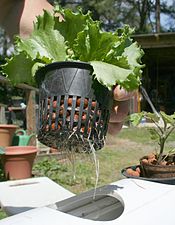Hydroculture
 |
| Supporting subjects |
|---|
| Topics |
|
|
|
|
This demonstrates the fundamentals of hydroculture gardening including: aquaponics, hydroponics, aquascaping, aeroponics, passive-hydroponics, plus hydroculture related gardening.
Subpages
[edit | edit source]Further information and projects.
Basics
[edit | edit source]Root zone
[edit | edit source]Roots must breathe oxygen. There is a limit to the amount of dissolved gasses that can be contained in water. Aquatic plant roots do not need direct access to oxygen in the water or medium, because these plants are adapted to transport oxygen throughout its physiological system.
Plant nutrition and additives
[edit | edit source]Dilute 1 tablespoon of fertilizer in a gallon container with water at a time before adding to system. (Adding too little is safer than adding too much). For non-hydroponic fertilizers use 1/10 of the dosing on the label, with the amount of water in the container in mind. The hoagland solution provides a basic reference point. (Please do more research on this).
Essential elements
[edit | edit source]Calcium, carbon, hydrogen, magnesium, nitrogen, oxygen, phosphorus, potassium, and sulfur are essential macro-elements. Oxygen, hydrogen, and carbon are obtained from water and air.[1]
Nitrogen, phosphorus and sulfur can be fixed by certain endophyte bacteria.
Boron, chlorine, copper, iron, magnesium, molybdenum, zinc and possibly nickel are essential micro-nutrients.[1]
Additives
[edit | edit source]There are other nutrients used or taken up by plants, but they are not considered essential.[1]
Sodium bicarbonate helps buffer pH levels.[1]
Hard tap water contains many, in some cases adequate, plant nutrients and sodium carbonate.[1]
Testing
[edit | edit source]Measuring the conductivity of the water (using a multimeter) is a way of analyzing the total dissolved solids. This indicates whether the water solution is within range, but this method doesn't test for nutrient imbalances. Test paper, or a ph and nutrient meter is required for more testing.[1]
Formulations
[edit | edit source]- 1 ppm=1mg/l [1]
The weight ratio of an essential element within a nutrient compound needs to be found, and the atomic weight of these elements and a chart is helpful to solve this.[1]
Contaminants
[edit | edit source]There are contaminants to plant or human health taken up by plants.
Disease and pest control
[edit | edit source]References and further reading
[edit | edit source]- ↑ 1.0 1.1 1.2 1.3 1.4 1.5 1.6 1.7 Resh, Howard (1998). Hydroponics: Questions and Answers for successful growing (in English). Mahwah, New Jersey: New Concept Press. ISBN 0-931231-96-5. http://www.howardresh.com/Howard-Resh-Books.html#.
IRC chat
[edit | edit source]- irc.freenode.net
- #hydroculture
- #aquaponics
- #hydroponics
